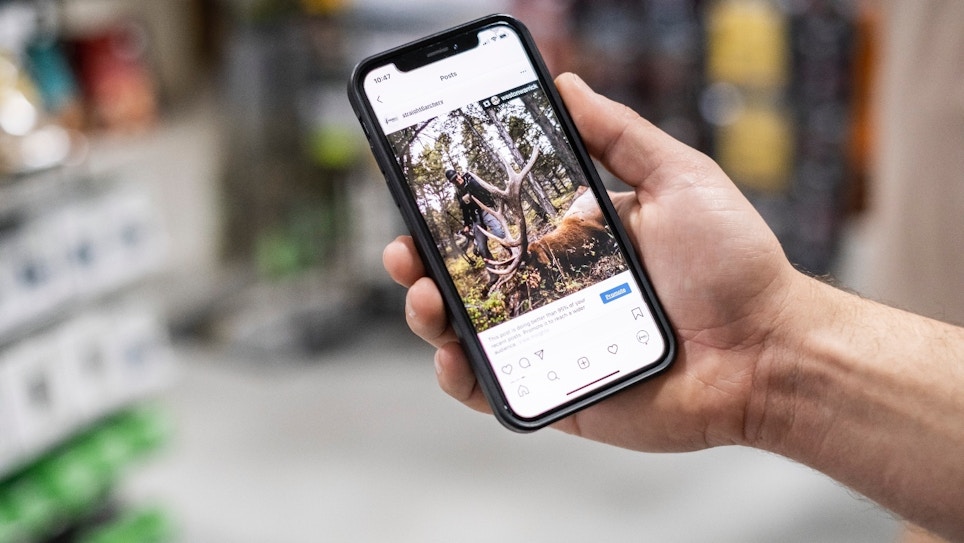
Social media marketing is its own category these days, but you should at least be active on the social platform your shoppers (and potential shoppers) use most.
Even if you think you’ve got a good handle on the marketing tactics that work best for your hunting customers, it’s a good time to review them — again — and make sure you’ve crossed all the t’s and dotted all the i’s. After all, while marketing philosophy in general may stay the same, the specific tactics change all the time. Moreover, your target audience is changing, too. Consider: You want to reach, among other demographics, modern 21-year-olds — an age group that now meets virtually every legal age requirement for just about any activity in the U.S., including hunting. These youngsters likely have their own transportation, income from steady employment, and a growing sense of independence. Most of them grew up with not only regular access to the Internet but also a smartphone or other mobile device constantly in hand. For them, learning and researching and shopping (along with a lot of other activities) occurs *online*.
Some are already hunters because of their upbringing; others will become hunters because another hunter invites them to try it or they seek out information on their own. If they’re young and/or a newbie to hunting, you won’t affect them with your marketing efforts unless your marketing efforts are online. Even hunters who are twice their age and older are more online than ever. Bottom line: Despite hunting being one of the oldest activities known to humankind, hunting retailers must market their products and services in ways that reach modern hunters or would-be hunters. That means your efforts must be online, digital, electronic, connected — whatever word you want to use that accounts for the current and future reality of marketing communications. But even if you already conduct a robust digital marketing program in your retail business, here are a few tips to keep in mind across four key digital marketing areas.
Keep Your Website (and All its Related Data) up to Date
At this point, it goes without saying that your retail business has a website. If you don’t, you pretty much don’t exist. Virtually everyone who has been interested in anything — this includes hunters who are shopping for gear, just to choose one of your target markets — has thought or uttered the phrase, “Let’s check out their website.” “Their website” could be your website — likely the first “face” of your business for any customer who wants to know more about you.
Two website “places” you need to concern yourself with: Your actual website, of course, but also where and how your website description shows up in search engine results. For the latter, search for your company or business name on Google or Bing or some other search engine and see where you show up in the list of results. Ideally it’s one of the first five or so results. If not, your website may need some search engine optimization (SEO) or other keyword or indexing help. Regardless of its ranking, once you see your company or business name in the search results, note what other information shows up near it — nothing, a tag line, a site description, the first words of the home page? This extra text is important and varies based on how your website is set up. But it can be changed, and here’s a quick exercise to make the point on its importance.
Consider which of the following is the more effective search result when searching for “Scooter & Wanda’s Hunting Emporium” (what I hope is a fictional hunting retailer name):
Scooter & Wanda’s Hunting Emporium
scooter and wanda’s hunting | home page description | insert phone number here | hunting retailers and supplies
Scooter & Wanda’s Hunting Emporium
Let Scooter and Wanda outfit you for your next hunting trip! Experts with over 20 years of hunting experience! Call 800-555-1212 or email the store at staff@scooterwandahunting.com.
I’m guessing Scooter and Wanda’s potential customers would be far more inclined to choose the second search result listing over the first. So what do internet searchers see when they search for your business?
In addition to where and how your company or business name appears in search engine results, your actual website, of course, needs to provide an excellent experience for every potential reader. Key items to keep in mind here are how fast the site loads (faster is better), its optimization for mobile (meaning the site changes layout to provide easier reading if someone is viewing it on their smartphone vs. the larger monitor of a desktop or laptop computer), and how easy it is to navigate. And, of course, the site should provide clean copy and great images and useful information that’s accurate and up to date!
Start and Maintain a Blog
A blog is usually a separate page or part of your website on which you provide regularly-updated content — articles, videos, infographics and more — related to your business and, most importantly, useful to your readers. The blog content differs from the other website content in type of content (more educational content vs overt marketing content) and frequency of update (more frequent). The blog should replace any “news” page on your website and should broaden to include less marketing- or sales-related content and offer more that is instructional or helpful to readers. Here are a few ways to differentiate the types and purpose of some content for your website and your blog:
- A website should provide product data; a blog should provide information on how to use those products, comparisons, etc.
- A website should provide information about the company and its history; a blog can provide this as well, but in multiple posts that provide greater details, personal anecdotes, etc.
- A website should provide frequently asked questions and answers about products, sales, shipping, warranty and more. A blog should provide inside information about how products are made and tested, customer testimonials, and more personal stories related to the products and services offered.
Here’s the key: Websites with active blogs generally rank better in search engine results and give the appearance (online) of the company being alive and active, willing to relay stories and information to readers, and attempting to build trust with readers by offering content not tied directly to an offer or coupon or discount.

Communicate on Social Media
You should be posting on Facebook, Instagram, YouTube, Snapchat, BeReal, TikTok, LinkedIn and other social media platforms — but only if you can tangibly prove that your posts are providing the appropriate return on investment. Otherwise, choose just one or maybe two social media platforms and focus on those. Social media platforms are great marketing tools IF they connect you and your company with customers and potential customers. This may take some trial and error, patience, and a willingness to change. In other words, don’t post only on Facebook because you happen to already be on Facebook. Your older customers may be; your younger customers may be elsewhere.
Recommended content for social media — as a means to market your products and services — include videos, photos and information about your business. This might include a video of an informal tour of your company, a short clip of an employee fulfilling an order, or videos or pictures of a company event. Keep it simple by using the camera on your mobile phone. Just keep the video short (30 seconds is great, but up to two to three minutes max) and well choreographed. Or, post well-composed photos of your staff using the products or services you sell. Make sure you have appropriate permissions in place and be sure to include a link to your website as a part of the photo or video caption.
Social media posts can be just simple text, too — but try to make them interactive. Offer a link to an online poll you create and see what your readers are thinking on a particular matter — serious or fun. Ask readers to submit their experiences with your products or services to an email address and then report on what you heard a week later. Whenever a new blog post goes up, announce it in a social media post with a link to the new blog content. The idea is to provide via social media a variety of content that engages readers, getting their attention and getting them to respond or share in their own social media feeds.
Elevate Your Email Marketing Efforts
Every now and then you probably get marketing emails. Some you open and some you don’t. Consider: What email subject lines capture your attention, causing you to open and read? What “from: address piques your interest? What emails do you actually look forward to receiving and opening? These facets of email marketing — what works for you in your email inbox — may be worth considering for your company’s email marketing efforts, too.
In fact, you should be sending out marketing emails that, for your current and yet-to-be customers, drive traffic back to your website or into your store, if you have one. Plenty of resources exist for how to start an email marketing program, but the key features include the following: capture customer and potential customer emails, use a good email marketing tool such as Constant Contact or MailChimp, and know your readers and communicate with them in a way that truly serves them.
To get email addresses, ask for them on your website, in your social media feeds and in your store. In exchange, offer truly useful content such as coupons or expert advice — this is where the blog (#2) comes in handy. Offer anyone you email the opportunity to easily unsubscribe and resubscribe — in other words, never spam anyone and follow proper email marketing etiquette. Finally, communicate systematically: with regularity and purpose, care and patience.





